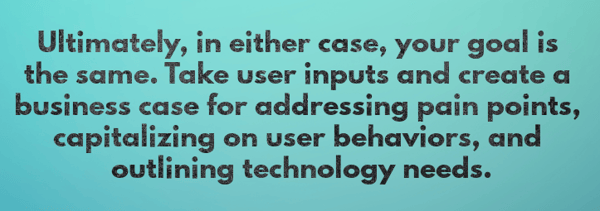Data. Users. Technologies.
That’s what drives system readiness, and if you’re building a connected business, they will need to be prepared for digital transformation. While this is no small task, our team has you covered. We developed a playbook on how to bolster those key drivers and improve your ability to pursue digital opportunities.
Whether you are a CEO or code programmer, this guide can help frame your thinking on how to:
- Standardize your data (e.g., use, collection methods, metrics)
- Support your users (both internal and external) through innovation
- Adopt high-value technologies (e.g., hardware, software, services)
Standardizing Data – It’s a pain, but it’s worth it.
Data is one of your most critical assets. Within its seemingly endless quantity, there are data insights which can improve your profitability, identify inefficiencies, enhance operations, etc. The list of potential benefits goes on and on. But, how to realize them?
We interviewed our members and worked with external partners to define recommended data practices for building a connected business. They include:
- Incorporating internal and external sources
- Establishing a common data environment
- Deepening insights with advanced analytics (e.g., prescriptive, predictive, etc.)
- Customizing your dashboards (e.g., where possible for different users)
- Enabling real-time insights through intelligent technologies (e.g., artificial intelligence)
- Offering interactive reports (e.g., data exploration equals comprehension)
- Ensuring mobile access
Standardized data is the foundation of a connected business. Think high relevance (e.g., necessary to migrate), high quality (e.g., free of errors, duplicates, etc.), high volume (e.g., collected from many sources, systems, spreadsheets, etc.), and high security (e.g., protected from cyberthreats).
Supporting Users – both internal and external
Take a look at our business system framework mapping how your lines of business fit together. This is a bird’s eye view of your company, and from this perspective, you get a better understanding of who uses which system.
Exhibit: NAED Business Systems Framework

Building a connected business will require adoptions and/or iterative improvements to the given platforms within each area (e.g., enterprise resource system, customer relationship management, business intelligence, etc.). It will be critical to connect with the users who interact with your technologies every day.
Internally, employees are your users. They touch your internal systems and will likely need guidance through potential changes to their daily activities as you build your connected business. We recommend engaging a representative sample of employee stakeholders (e.g., platform users and owners) to:
- Collect input across functions and titles
- Identify pain points and generate buy-in for new objectives, improvements, changes, etc.
- Provide training and mentoring opportunities
- Appoint change or solution champions to pilot test solutions
Externally, customers are your users. While your customers do not interact with every system or platform you have (e.g., as your employees do), they do drive your revenue engine. We recommend engaging a representative sample of your customers to:
- Assess the performance of current offerings (e.g., strengths and weaknesses)
- Test the validity of your new offerings (e.g., hardware, software, and/or services)
- Unpack a range customer use cases and how to address unmet needs
- Determine where personalization is needed (e.g., interactions at scale)

Adopting High-value Technologies – how to plan ahead
We could write an entire post on this topic alone, and actually, we already did. For in-depth information on what technologies should be pursued and when over the next 5 years, please check out our strategic paper (NAED’s Building a Connected Business). It’s a thorough summary of recent workshops we held with NAED members to unpack and validate 21 digital opportunities ripe for electrical distributors.
There are lots of things to consider when assessing which technologies will propel the digital transformation of your systems – from budgetary constraints to feature requirements and service agreement terms. But, if you are looking for low-hanging fruit actions to take within your current enterprise, here’s what we recommend:
- Integrating systems and eliminating silos
- Automating routine processes
- Adopting intelligent technologies
- Incorporating social channels
- Enabling collaboration and visibility
- Iteratively introducing new system features or functionalities
- Live testing solutions prior to deployment
Wrapping up
Taking stock of your data, users, and technologies can help you assess where you are as a company and what your systems can handle. It’s the first step on the journey to build a connected business. Now, keep calm and digitize on!
Download the executive summary of NAED's newest research study and roadmap for building a business that keeps pace with ever-changing technology needs and trends. Or learn more about resources you can use when it comes to Building a Connected Business plan by reading this blog post.

